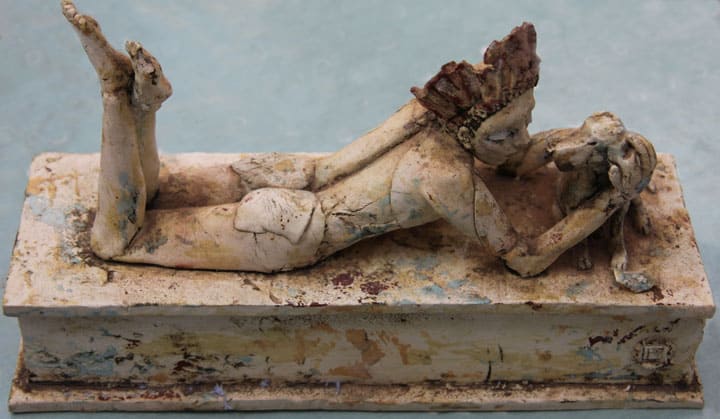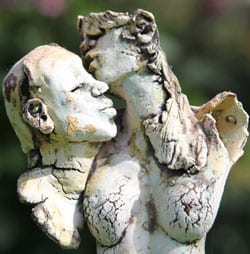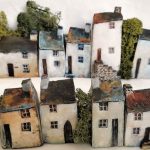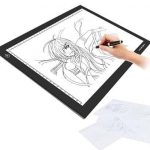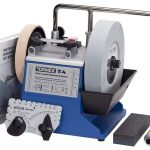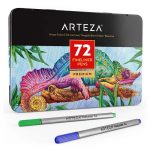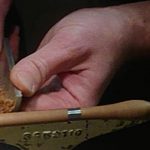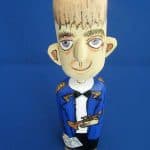Podcast #1 Clay Modelling artists – Michelle James
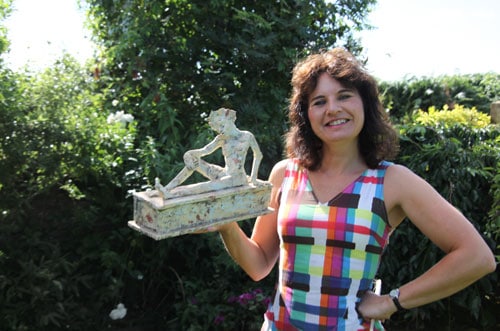 Michelle James (artist name Michelle Harris) is one of the most exceptionally talented clay modelling artists I have seen for quite some time.
Michelle James (artist name Michelle Harris) is one of the most exceptionally talented clay modelling artists I have seen for quite some time.
I first discovered her cool clay sculptures by accident through a mutual friend. I don’t state this praise lightly as she is naturally gifted in this craft form and produces some fascinating and outstanding pieces of art.
Classical tribal sculptures made out of clay
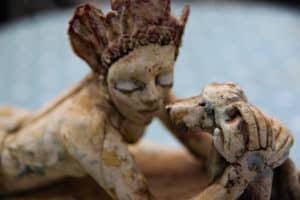 Her creations are intuitive, ethereal and beautifully crafted and I believe that she will soon make a serious impact on the clay sculpting world.
Her creations are intuitive, ethereal and beautifully crafted and I believe that she will soon make a serious impact on the clay sculpting world.
Her work is along classical lines and usually centres upon the female form particularly on the torso. She takes her inspiration from inflences such as Africal Tribal and Egyptian women and has created a marvellous style using thin layers of clay over the main structure.
Each sculpure is enhanced with different colored slips which involves several visits to the kiln. This effect works incredibly well to give the appearance of old weathered artifacts with peeling and often crumbling, crazed surfaces.
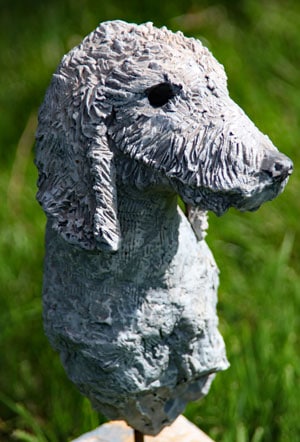 Michelle is originally from Herefordshire, England and lives with her husband and son in the picturesque village of Wormsbridge on the English / Welsh border.
Michelle is originally from Herefordshire, England and lives with her husband and son in the picturesque village of Wormsbridge on the English / Welsh border.
She attributes her inherent artistic flair to her father who is a fine artist in his own right. She said that her upbringing with an artistic parent was pivitol and was soon painting pets and other animals for friends and family. She studied art at Pontypool College in South Wales when she was 18 and later returned to academia at Hereford to obtain an art degree at the age of 31.
Life as an art student involved many strands of art and craft studies but Michelle has always been happiest with her hands sculpting figures with clay and believes that there is more than a worldly connection between artist and the clay medium.
Clay sculpture ideas through a past connection
She is able to feel a connection through her hands with the clays past. This connection gives her the inspiration and ideas for her creations.
I asked her how she developes each project. Like many artists that I know (and I include myself) she does not pre-plan to a greater degree (and disliked this aspect in college and university).
Michelle said that she has an inkling of an idea and as the project progresses the clay ‘speaks to her’ (although not in the literatal sense!)
She feels that this ‘inner dialogue’ with the clay directs her progress with each project.
I said that this ‘was being artistsic’ but Michelle said it was more than that, being able to feel the clays past history.
Modelling in sculpture for the outdoords
While I discussed her craft I took several photo’s of her work mainly outside in a garden setting. It struck me that her sculpures would really suit an external setting particularly if the structures were larger. She agreed with this but had yet to purchase a larger kiln and needed a dedicated workspace area.
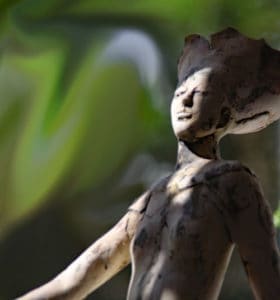 Michelle’s artistic output has been recently ‘off the boil’ but insisted that she fully intends to get right back into the creative mode. I sincerely hope she does because her sculptures are exquisite and I am sure be well recieved by any art gallery or art conniseur.
Michelle’s artistic output has been recently ‘off the boil’ but insisted that she fully intends to get right back into the creative mode. I sincerely hope she does because her sculptures are exquisite and I am sure be well recieved by any art gallery or art conniseur.
I had the pleasure of catching up with her to discuss her artistic origins, where the route has taken her and how she constructs her clay sculptures.
The following short podcast I had with Michelle (see below to play the podcast) reveals much more about this highly talented artist. You can feel her enthusiasm for clay sculpting in abundance and the only downside is that I believe Michelle is yet to realise how good she really is!
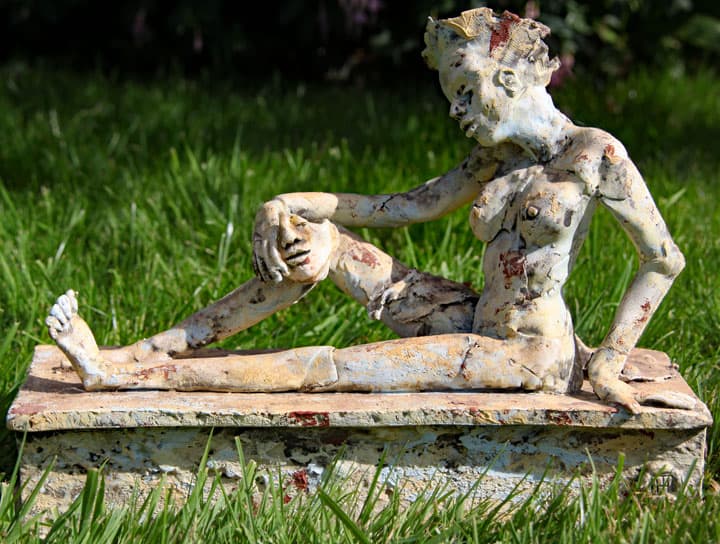
Listen to the Podcast of Michelle James, Clay Modelling Artist here…
If you would prefer to read the transcript of the podcast interview with Michelle James please scroll down the page…
Michelle James Gallery – Clay Modelling Artist
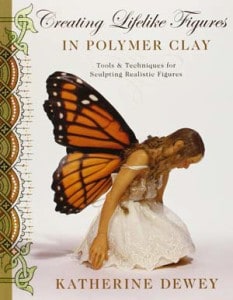 If you would like to venture into clay modelling why not start out with polymer clay which can be ‘home baked’ without the expense of a kiln.
If you would like to venture into clay modelling why not start out with polymer clay which can be ‘home baked’ without the expense of a kiln.
We review 5 top rated books on clay modelling to get you started more…
Transcript of the Podcast with Michelle James – Clay modelling artist
Rob: Hi, I’m Rob Nesbitt and this is the “Crafts Finder Podcast.”
This is the very first podcast in which I talk to Michelle James, a talented clay modelling artist and pottery sculpter based in the UK on the English Welsh border in Herefordshire. I discovered Michelle’s work through a mutual friend who had some pieces of her pottery on display at home. I had assumed that she must have bought the pottery from a very expensive gallery as they’re superbly crafted and really appealed to me. In the short discussion with Michelle James, I delve into her artistic background and the concept behind her very distinct style.
Rob: When did you first start becoming interested in art and particularly pottery?
Michelle: Art, definitely, because I grew up with it. My dad’s an artist and he’s always painting so it’s always been going on in the house. And pottery, I went to college…oh no, it started off in Pontypool when I was about 18. I went back to do my diploma. And you touch on everything, art, ceramics, metalwork, woodwork. And I really liked the feel of clay and the way things just created. I just loved it. You know how you can turn a block in, and oh, and just, something seductive about getting your hands in clay and something comes out of it. And you can make it up as you go along and alter it just like Play-Doh. Like a child with Play-Doh. And when you grow up it’s no different, really. Only you get to fire it. And it lasts a bit longer.
And then, obviously, I got jobs and then I had my son, and then decided I didn’t wanna waste what I’d already started and went back when I was thirty-one to Hereford Art College to get my degree. Which I did for three or four years. Oh yes, I stayed for an extra year for a top level, which made it a degree I think. And again, I seem to get back into the clay. It was metalwork, woodwork, we touched on it all again. But I was always drawn to clay. And I love drawing and painting as well. But the, yeah, something about clay that I always seem go back to. But I love painting as well, mind, I must say. I love doing wall murals. I done one a couple of days ago of a lavender fields, outdoor in a garden. And I just loved getting back into the paint. You can mold paint like, just like it’s, like clay, isn’t it? It’s like a texture as well. So I suppose to me, it’s all the same.
Rob: Your style is quite unique, I think. It’s very, sort of, got a classical feel about it.
Michelle: It’s a bit…yes, I think grab bits and pieces from everywhere. I love renaissance women, you know, but then they’re not… Then I love the Egyptian, all the wall…when you go in the Egyptian Pyramids. I love that. Oh, and it’s all flaked away and you can only just see the remains. And that’s what I try to create on the outside. And I like the idea of that drawing, I love to do. It’s something that…is, oh what do you, recycle clay?
Rob: Yeah.
Michelle: And I like to call it recycled souls because, to me, you don’t know where this clay has been. You don’t know what’s gone on in that clay. But when you’ve got it in your hands, it’s something about the earth, isn’t it? And you’ve drawn it out. And I want to, I want something to come through and I’m recycling a soul. And I actually feel like something is coming through and I wanna produce it. Like it’s not just me. I want the surfaces to look like, like antique. And, so, as if the layers have dropped and way and it’s leaving just the remains of something. I think that’s what I want to feel.
And they’re like human to me. I know when I’m working on the faces, it’s like I’m talking to them. I’m feeling them. It’s just like a person is coming…developing.
Rob: I know exactly what you mean because I do a lot of cartoon work and you start off and it’s just a shape. And then you’ll have the eyes and there’s suddenly a bit of character to it. And then suddenly it pops up into your head, “Oh this is what they’re going to look like.” And you do a line, and it takes you to another line. I suppose with clay, it’s exactly the same.
Michelle: It is exactly the same.
Rob: You grab a lump and you say, “Oh, that’s interesting.”
Michelle: You can feel. You feel it. And you can see them coming through. I don’t know, a little bit deep and arty.
Rob: It’s called artistic.
Michelle: I like to think it a bit more than that. I don’t normally talk about it. It’s something I feel. It’s hard to portray what you’re feeling into words without looking silly. But that’s how I feel, it’s like as if there’s somebody coming through, up through the clay and I’ll say, “Nice to meet you.” They don’t talk to me back, though, else It would get a bit far-fetched!
Rob: So, for example, the piece that nobody can see because we’re talking (image below), but there will be a picture of it on the article on the website. This is of what? Or hasn’t it got a “what?”
Michelle: I think there’s a…I know when I was making this, when it was a bit of a story to it. There was, like, a person behind the mask. She’s taking her mask off and she’s showing who she really is. And then I think I was in one of my tribal, I felt drawn to tribal, and she’s a bit African to me. So that’s why she’s got a bit of a draper going around her. Obviously, it was a day, or two days later I’m doing a surface decoration, so I might be doing a different mode. I might have moved from my tribal to my Egyptian so that’s why it’s got the…
Rob: Well, that’s the beauty of art. It can evolve as you go along.
Michelle: I build on them. Yes, I build them over the weeks or, well, I usually do one, complete it within a week.
Rob: From start to finish, a week.
Michelle: From start to… Well, at firing, according to the firing, obviously, it’s gotta be fired three times, so, according to what I need…I got to go into the kiln. I might do it within a week, or if I’ve not go enough to fill my kiln I’ll have to wait, like, a week or two.
Rob: Do you do everything yourself? I mean, you’ve got your own equipment, your…
Michelle: I am, I’ve self-setup. Yes, got my kiln. Unfortunately, my husband has taken away my worktop so I can’t do any at the moment. Yes, once I get my worktops back, which my husband has taken a way to redo our [inaudible 00:05:54] I will start doing some more. But, yeah, I’m self-setup once I get my worktops back. I got my kiln, all my own glazes.
Rob: With glazing, do you apply all the colors at once or are they done separately?
Michelle: The colored slips are put on first which I dab on, I wash off, and I keep working on that. Then I’ll put it on some paper and just before it gets too dry I’ll rub it over the surface which leaves the little blemishes. Then I’ll fire it and then I’ll put on the oxides which brings out the details.
Rob: So the planning of the piece, then, isn’t something that you would sit down and plan out on a piece of paper. You just get on with it. You’ve got an idea, rough idea and that evolves as you go along.
Michelle: It’s funny because in college, they do like you to plan things. And I always found that so difficult because I like, I say, I like to feel something coming through at the time. So I never plan a piece. I just feel it. I might have a rough idea, sometimes I’ll get a vision. But it never seems to turn out as I imagine it. So I do like to sit there and let the clay find it’s own way through me.
Rob: Does it surprise you sometimes? I mean, does it turn out better than you expected?
Michelle: Oh, very often, very often. And it can go the other way, too. But, yes, it’s nice when it does work like that.
Rob: With a lot of artwork, do you revisit a piece? Like you’re looking at this again, does it still look the same after you’ve just done it, or does it change over time? The reason I’m asking is because very often, I’ll finish a cartoon, I’ll think that’s pretty good, put it away. And I look back like six months later and I think, “Oh, that was very good,” or, “It was rubbish.”
Michelle: Oh yes, yes, yes. Certain elements and features I’ll either like or dislike. But they’ve always got the same whatever I was feeling at that time. Whether it’s. you know, my tribal, or the Egyptian, or just something completely different. I’ll always have those same feelings. That doesn’t change.
Rob: Do you still sell your art?
Michelle: No, not at all for the last few years. No.
Rob: That’s a shame, that.
Michelle: Because I have no worktops that my husband hasn’t replaced. But, yes, I keep intending to. But life takes over sometimes…
Rob: It does.
Michelle: And I’m afraid the last few years other things have taken over. But it’s always there so that I’m gonna get back to it. All the time, on the brink.
Rob: So, you will at some stage.
Michelle: Oh, for sure.
Rob: Yeah, I think you should because it’s too good not to.
Michelle: Yes. There’s some inside I just want to get back. And my hands move. Sometimes I can be walking the dogs and my hands are doing it as I’m walking. Stupid, but I’m walking and I’m just doing things and I’m feeling. And I’ll see a feather or I’m gonna… The next one I do is gonna be a tall upright with a feather skirt and I start collecting the feathers, ready to make the next one. But, I haven’t quite got the clay out. Or when I do it’s gone hard and then I go to my little work surface that I had and there’s a boat engine there, so things have happened over the last few years that always stop me. But I will get my space back.
Rob: The piece that we’re looking at, is part, I suppose you’d call a slab, slab work?
Michelle: It is, the bases are always slab built. Yes. Again, I suppose I started off making slab bases, I haven’t moved on from it. I did make rocks to make them look like they’ve sat on a rock once. That’s just worked for now for the…because they’re quite delicate, you need quite a solid base. But it does make them rather large for people to put on their mantle pieces. Or I would love to go into garden sculpture. I would like to go bigger, actually, but my kiln is only two foot by two foot, so it doesn’t allow them to be too big. It’s a dream. I’d like to go bigger. Garden sculpture.
Rob: Yeah, no. I agree with it because some of the folders have taken of your work, and we’ve taken outside and it really does lend itself to that. Definitely.
Michelle: They do, yes, I agree. And I love the torsos. I’d like to actually take a body, oh, what would you call it? A mold, like a mold of a body and do torsos. Twisted spines. I don’t know. It’s all going on inside ready to come out.
Rob: Would it be safe to say that you start with the base to give it the support? Is that the first thing you would do?
Michelle: No, I make quite a few bases, but they take a while actually because you’ve got to dry out the slabs to certain, like they’re leather hard before you can cut them. So I’ll probably do four or five bases in a few days and then wrap them up and put them aside so the bases are ready. So then the next stage then, when I…when it takes me, I will work on the base making my female form. Or male sometimes.
Rob: Do you use other supports for the main section of it?
Michelle: I do because according to how quick I’m working, if I get to a certain stage too fast, then obviously they start to sink in the middle. So I do use a lot of structures. Just, just, like, little wooden sticks, or even metal poles and a bit of armature to support them while they’re drying out.
Rob: Are there clay artists or other artists that have influenced you?
Michelle: I think if you’re an artist you’re always looking at other people’s work or something catches your eye. So, I think you’re influenced daily by anything. Not even…It doesn’t have to be art. It can be, I don’t know, just a piece of something you find in a cupboard as you’re cleaning, you know. So you’re always influenced by something from everywhere.
Rob: Have you ever created something you thought, “Yeah, it’s great.” And then it’s just either exploded in the kiln and you’ve…
Michelle: I’ve had a few losses in the kiln, actually. One of the last pieces I did was a dragon and somebody had commissioned it and they wanted it as big as possible. But I think rushed it and didn’t let it dry out. Which put me off, because all that work, and it did explode in the kiln. There was, sort of, three big bits left, which I tried to glue it together, but I certainly couldn’t have sold it.
Rob: So how many days work was that down the
Michelle: Oh, it was about a whole week. Yes. And it was stoneware, so..they wanted, they wanted it to go outside. I’d never worked in stoneware before so perhaps I’d done something. I think perhaps I should have let it dry out a bit more. But I have lost a few pieces. Not too many. But when you’re in college, obviously, other people’s mistakes will also affect your own work. So I’ve lost a few from that. Actually, you took a photo of a dog I did earlier. A dog’s head. There was a body to that. There was a body to that. It was a full dog. But, again, I think I rushed it. You’ve got to let them dry out thoroughly.
Rob: Do you do any other pets? Or is it just…was that just a one-off?
Michelle: I grew up doing lots of paintings. I was commissioned for dogs. Although I was never really that good at people. My dad is fantastic. You sit there and within seconds you know it’s them. But I’ve never been much good with people on paper. Animals, yes. Obviously, they’re covered in fur so it’s not as difficult, is it?
Rob: Right, well, hopefully, you’ll be back in there, the workshop.
Michelle: I really, I actually, yes, I bought some paints last night on Hereford online car boot sale which I’m collecting today. Am I gonna get back to my sculpture? For sure. Oh, definitely artwork and sculpture. But I will invest in some new fresh clay so when I get my worktop back, which my husband promised me last night, I will be straight back into it this year. I intend to.
Rob: That will be brilliant. And, you don’t have a website or a…
Michelle: I used to.
Rob: …contact details or anything if somebody did want to commission you? Would you be still up for that or…
Michelle: I’d like to say yes, but it frightens me until I get things up and running again because my kiln has been taken over by bees and things so. And it’s actually got a few bits in there ready to be fired. But the answer is yeah.
Rob: Okay Michelle, it was lovely to speak to you.
Michelle: And you, too.
Rob: I do hope that you start producing some more of your fantastic work in the near future.
Michelle: Thank you. I will.
Rob: I hope you’ve enjoyed this first podcast. If you’re a craft artist and have a story to tell, please contact me via the About Us contact page on the craftsfinder.com website.
SaveSave

